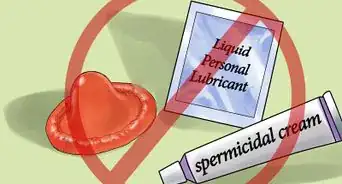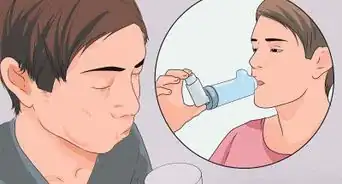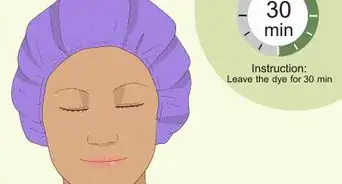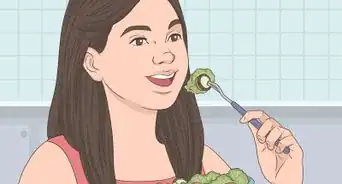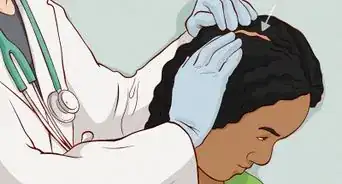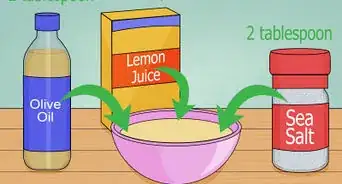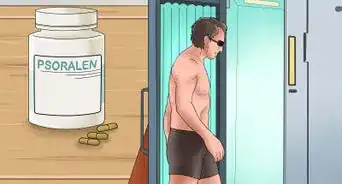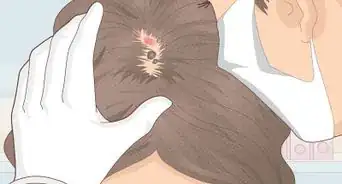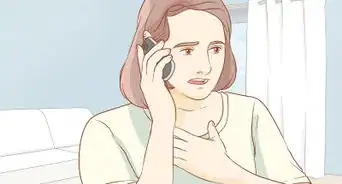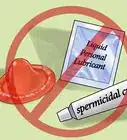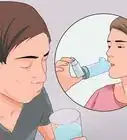This article was co-authored by Ritu Thakur, MA and by wikiHow staff writer, Megaera Lorenz, PhD. Ritu Thakur is a healthcare consultant in Delhi, India, with over 10 years of experience in Ayurveda, Naturopathy, Yoga, and Holistic Care. She received her Bachelor Degree in Medicine (BAMS) in 2009 from BU University, Bhopal followed by her Master's in Health Care in 2011 from Apollo Institute of Health Care Management, Hyderabad.
There are 14 references cited in this article, which can be found at the bottom of the page.
wikiHow marks an article as reader-approved once it receives enough positive feedback. This article has 27 testimonials from our readers, earning it our reader-approved status.
This article has been viewed 7,709,065 times.
Dandruff, those annoying little white flakes that build up in your hair, can be an embarrassing nuisance. Luckily, it’s usually possible to get rid of it using over-the-counter dandruff shampoos. If you’re concerned about the ingredients that might be in commercial remedies, there are natural alternatives—for example, you can wash your hair with some diluted tea tree oil or massage your scalp with aloe vera gel. Additionally, try making some lifestyle changes to improve the health of your scalp. If your dandruff is severe and home treatments aren’t working, talk to your doctor.
Steps
Using Topical Treatments
-
1Mix tea tree oil into your shampoo to moisturize your scalp and fight fungus. Dandruff can be caused by an overgrowth of fungus on your scalp. The natural antimicrobial and antifungal properties of tea tree oil may help combat this problem. Purchase a shampoo with a 5% concentration of tea tree oil, or put 5-10 drops of tea tree oil into the bottle with your regular shampoo and shake it up thoroughly, then wash your hair as usual. Continue using this treatment until your dandruff improves.[1]
- Tea tree oil is toxic when swallowed. Never use it in or near your mouth.
- If you accidentally get tea tree oil in your eyes, rinse them immediately with warm water and call your doctor if you experience redness or irritation.
- Don’t apply undiluted tea tree oil directly to your scalp, since it can cause itching and irritation. Stop using any products containing tea tree oil if you experience an allergic reaction, such as a rash, itching, stinging, or burning.[2]
EXPERT TIPRitu Thakur is a healthcare consultant in Delhi, India, with over 10 years of experience in Ayurveda, Naturopathy, Yoga, and Holistic Care. She received her Bachelor Degree in Medicine (BAMS) in 2009 from BU University, Bhopal followed by her Master's in Health Care in 2011 from Apollo Institute of Health Care Management, Hyderabad.Natural Health Care Specialist
 Ritu Thakur, MA
Ritu Thakur, MA
Natural Health Care SpecialistExpert Trick: Add 1 teaspoon of lemon juice to your topical treatment. Lemon juice not only smells great but can also work to neutralize your skin pH and get rid of dandruff!
-
2Use lemongrass oil mixed into shampoo to soothe inflammation. Like tea tree oil, lemongrass oil has antimicrobial properties that may be helpful for treating some types of dandruff. It can also reduce inflammation of the scalp. Get a 10% lemongrass oil shampoo, or add a few drops of lemongrass oil to your regular shampoo or conditioner.[3]
- You may need to use the lemongrass oil treatment for 2-3 weeks for the best results.
- Don’t apply undiluted lemongrass oil directly to your scalp, since it may cause irritation.
Advertisement -
3Massage some aloe vera gel into your scalp for a soothing treatment. To treat dandruff, rub a generous amount of pure aloe vera gel directly into your scalp and let it sit for up to 1 hour. When you’re done, wash your hair with a mild shampoo and rinse your hair and scalp thoroughly. Use this treatment 2-3 times a week until your symptoms improve.[4]
- Aloe vera gel is rich in antioxidants and amino acids, and its moisturizing and anti-inflammatory properties may promote faster healing of damaged or irritated skin. It also has antifungal and antimicrobial properties. All these factors make aloe an excellent natural dandruff treatment.[5]
- You can either purchase aloe vera gel or collect some directly from the cut leaf of a live aloe plant.
- Some people find aloe gel irritating, so dab a small amount on your wrist and watch for a reaction before applying it to your scalp. Ideally, you should wait a full 24 hours to see if there’s a reaction, but you’ll likely notice something sooner.
- Stop using aloe if you experience symptoms such as a rash, itching or irritation, or increased sensitivity to sunlight (i.e., your skin burns more easily than usual).
-
4Try a coconut oil treatment to reduce inflammation and add moisture. While there’s not a lot of research on the effectiveness of coconut oil for treating dandruff, there’s some evidence that it can help with related skin conditions, such as atopic dermatitis.To use coconut oil, rub 2 tablespoons (30 mL) of the oil directly into your scalp and let it sit for 5-10 minutes before rinsing it out.[6]
- You can also put a shower cap over your hair and leave the coconut oil on your scalp overnight if you wish. Rinse the oil out with warm water when you get up in the morning.
- You may need to warm up the coconut oil by rubbing it between your hands for a few minutes or mixing it with a small amount of warm water before you can spread it over your scalp.
- Another option is to purchase shampoo that contains coconut oil.
- Look for pure coconut oil in your local grocery store or health food store.
-
5Wash your scalp with baking soda for a deep, exfoliating clean. Baking soda can scrub away dandruff flakes and may also help fight the fungus that sometimes causes dandruff. To clean your scalp and hair with baking soda, make a paste using 3⁄4 cup (180 mL) of water and 4 tablespoons (58 g) of baking soda. Work the mixture into your scalp and hair and let it sit for 1-3 minutes before rinsing it out.[7]
- If you like, you can also add a few drops of tea tree oil for extra dandruff-fighting benefits.
- Using baking soda on your hair too frequently can dry out your hair and irritate your scalp. Try using this approach no more than once a week, and stop if you experience irritation or notice that your hair is becoming dull and dry.
- You can offset some of the harsh effects of baking soda by following up with a moisturizing conditioner containing coconut or argan oil.
-
6Add crushed aspirin to your shampoo for a homemade salicylic acid wash. Aspirin contains salicylic acid, a compound that occurs naturally in the bark of willow trees. Because it can help clear oily skin and reduce inflammation, salicylic acid is a common ingredient in dandruff treatments. Try crushing up 1-2 uncoated aspirin tablets and mixing them with 1 tablespoon (15 mL) of your shampoo next time you wash your hair. Shampoo your hair as usual, but leave the shampoo on your hair for 2-3 minutes before rinsing it out.[8]
Making Dietary and Lifestyle Changes
-
1Incorporate more omega 3 fatty acids into your diet. Omega 3s are a type of healthy fat that may improve your skin and hair’s health, among other benefits. If you struggle with dandruff, try eating more foods that are rich in omega 3s, such as fatty fish (like salmon, mackerel, and tuna), nuts, seeds, and seed oils.[11]
- You can also get omega 3 fatty acids from supplements, such as fish oil tablets.
- Aim to eat 1.1 to 1.6 grams of omega 3 fatty acids each day.
-
2Eat a diet rich in fruits and vegetables to reduce your risk of skin disorders. Studies show that people who eat plenty of fruits and vegetables are less likely to develop skin conditions related to dandruff, such as seborrheic dermatitis. Try eating a rainbow of fruits and vegetables each day so that you get a variety of essential nutrients, vitamins, and minerals.[12]
- Good vegetable options include leafy greens, beans and peas, cruciferous vegetables (such as broccoli and cauliflower), and colorful veggies like carrots, radishes, peppers, and purple sweet potatoes.
- You can also get a range of vitamins and minerals by eating a wide variety of fruits, including berries, apples, citrus fruits, bananas, grapes, and melons.
- Aim to eat 5 servings of vegetables and 4 servings of fruit each day. Check a chart like the one here to determine how large a single serving is for various kinds of veggies and fruits: https://www.heart.org/en/healthy-living/healthy-eating/eat-smart/nutrition-basics/what-is-a-healthy-diet-recommended-serving-infographic.
-
3Consume more biotin-rich foods to support healthy skin and hair. Biotin is an essential B vitamin that can help improve the health of your hair, skin, and nails. Talk to your doctor about taking biotin supplements, or get it from food sources, such as:[13]
- Egg yolks
- Nuts
- Salmon
- Liver
- Nutritional yeast, which you can use as a topping in place of butter or cheese, or stir into creamy soups or egg dishes.
-
4Talk to your doctor about taking zinc to boost healthy cell growth. Zinc is an important dietary mineral that plays a role in keeping your immune system healthy. It may also promote faster healing and help prevent conditions that affect your skin, hair, and scalp. Talk to your doctor about whether zinc supplements might be helpful to you.[14]
- You can also get zinc from dietary sources, such as red meat, shellfish, legumes (such as chickpeas and lentils), nuts and seeds, eggs, dairy products, whole grains, and potatoes.[15]
Did you know? Zinc can also be helpful as a topical treatment. It’s a common ingredient in dandruff shampoos.
-
5Do stress-relieving activities to improve your overall health. The relationship between stress and dandruff isn’t clear, but some studies show that people with high levels of stress and anxiety are more likely to have skin conditions like atopic dermatitis. If you already have dandruff, it’s possible that stress can make it worse.[16] If you’re stressed, try to minimize it by:
- Doing relaxing activities, such as yoga or meditation
- Spending time with friends and family
- Engaging in hobbies and creative activities that you enjoy
- Listening to peaceful music
- Getting plenty of good-quality sleep
Seeking Medical Treatment
-
1See your doctor if you notice signs of infection in your scalp. Dandruff doesn’t usually require medical treatment, but sometimes it can be associated with more serious conditions. There’s no need to see your doctor if you have some flakes with no other symptoms. However, you should make an appointment if you have dandruff accompanied by symptoms such as redness, tenderness, or swelling in your scalp.[17]
- Symptoms like these could also indicate that you have another skin condition, such as seborrheic dermatitis.
-
2Get medical treatment if your dandruff is severe or doesn’t respond to home care. If you have very heavy dandruff or if home treatments aren’t helping, it may be time to see a doctor. You should also call your doctor if you have severe itching and discomfort along with dandruff. They can identify the cause of your dandruff and prescribe an appropriate treatment.[18]
- For example, if your dandruff is caused by an inflammatory disease, a corticosteroid treatment or immune response inhibitor might help.
- For persistent fungal infections of the scalp, your doctor might prescribe a strong antifungal shampoo or medication.
Tip: As a rule, it’s a good idea to see your doctor if you’ve been using home remedies or over-the-counter dandruff treatments for at least 1 month with no improvement.[19]
-
3Seek medical attention if you have dandruff with a weakened immune system. If you have a condition that weakens your immune system, such as an inherited immune deficiency disorder, HIV/AIDS, cancer, or diabetes, call your doctor if you develop dandruff. Your doctor can check if the dandruff is caused by an infection in your scalp, and treat it if it is.
- Some medications, such as steroids and chemotherapy drugs, can also weaken your immune system. See your doctor if you develop dandruff while taking one of these medications.
- Untreated skin infections can lead to serious complications if you have a weakened immune system, so don’t hesitate to get it checked out.
Warnings
- You may have heard that massaging oil into your scalp—such as olive oil or mineral oil—can help get rid of dandruff. However, while this treatment can make it easier to remove flakes from your scalp in the short term, it may ultimately make the problem worse.[20]⧼thumbs_response⧽
References
- ↑ https://www.webmd.com/vitamins/ai/ingredientmono-113/tea-tree-oil
- ↑ https://www.mayoclinic.org/drugs-supplements-tea-tree-oil/art-20364246
- ↑ https://www.webmd.com/vitamins/ai/ingredientmono-719/lemongrass
- ↑ https://www.mayoclinic.org/diseases-conditions/seborrheic-dermatitis/diagnosis-treatment/drc-20352714
- ↑ https://www.mskcc.org/cancer-care/integrative-medicine/herbs/aloe-vera
- ↑ https://www.webmd.com/vitamins/ai/ingredientmono-1092/coconut-oil
- ↑ https://www.webmd.com/skin-problems-and-treatments/features/natural-fixes
- ↑ https://www.mayoclinic.org/diseases-conditions/seborrheic-dermatitis/diagnosis-treatment/drc-20352714
- ↑ https://www.drugs.com/sfx/salicylic-acid-topical-side-effects.html
- ↑ https://my.clevelandclinic.org/health/drugs/18685-salicylic-acid-shampoo
- ↑ https://www.webmd.com/skin-problems-and-treatments/features/natural-fixes
- ↑ https://www.webmd.com/skin-problems-and-treatments/features/food-link
- ↑ https://www.webmd.com/skin-problems-and-treatments/features/food-link
- ↑ https://www.webmd.com/skin-problems-and-treatments/features/food-link
- ↑ https://ods.od.nih.gov/factsheets/Zinc-HealthProfessional/
- ↑ https://www.nhs.uk/conditions/dandruff/
- ↑ https://www.nhs.uk/conditions/dandruff/
- ↑ https://www.health.harvard.edu/skin-and-hair/what-is-the-best-way-to-treat-severe-dandruff
- ↑ https://www.nhs.uk/conditions/dandruff/
- ↑ https://www.livescience.com/22478-dandruff-cradle-cap-treatment-oil.html
About This Article
To get rid of dandruff naturally, mix together 3/4 cup of water and 4 tablespoons of baking soda, then work the paste into your hair for a few minutes before rinsing it out. The paste can help scrub away dandruff flakes and fight dandruff-causing fungus, but don't use it more than once a week since it can dry your scalp out. For an everyday solution, add 5 to 10 drops of tea tree oil to your bottle of shampoo, then wash your hair as usual. The tea tree oil can help combat fungus and bacteria on your scalp that may be causing your dandruff. Alternatively, if your scalp is feeling irritated, try rubbing some aloe vera gel into it to reduce inflammation. Leave it in for 1 hour before rinsing it out, and repeat 2 to 3 times per week. To learn how to get rid of dandruff naturally by making changes to your diet, scroll down!
-Step-1-Version-8.webp)
-Step-2-Version-8.webp)
-Step-3-Version-8.webp)
-Step-4-Version-8.webp)
-Step-5-Version-8.webp)
-Step-6-Version-8.webp)
-Step-7-Version-8.webp)
-Step-8-Version-8.webp)
-Step-9-Version-8.webp)
-Step-10-Version-8.webp)
-Step-11-Version-7.webp)
-Step-12-Version-7.webp)
-Step-13-Version-7.webp)
-Step-14-Version-7.webp)
